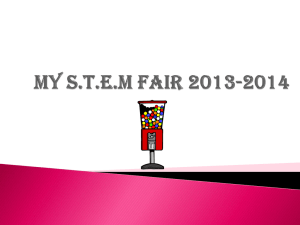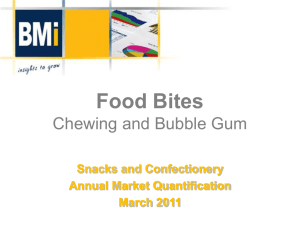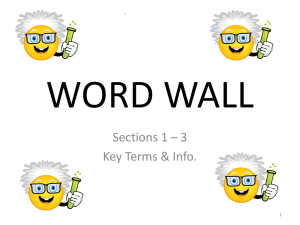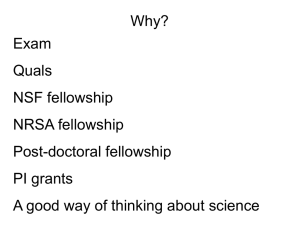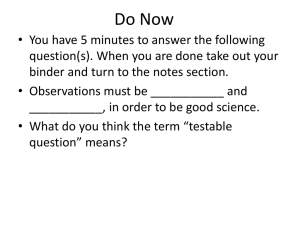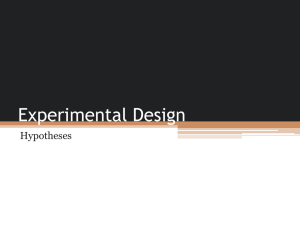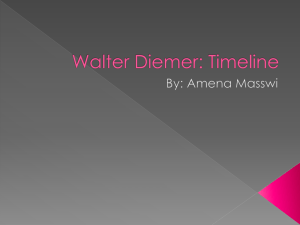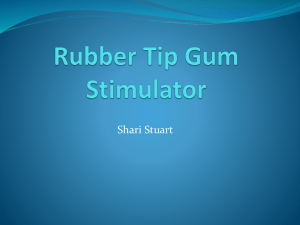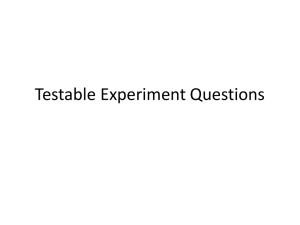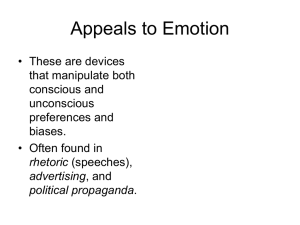File
advertisement
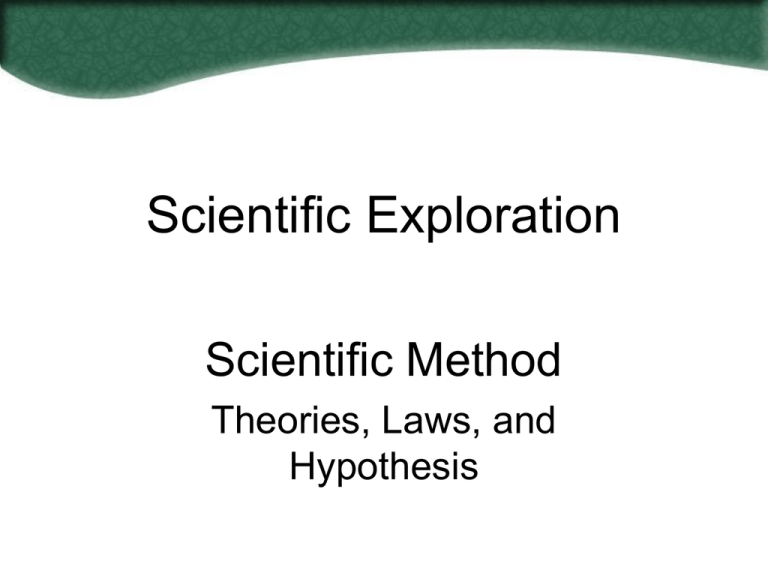
Scientific Exploration Scientific Method Theories, Laws, and Hypothesis • Bell Work (5 min): • Write homework for tonight in agenda Think it Through: 1. Write a testable question for the bubble gum lab. 2. How will your observations & Inferences help you design a lab experiment? (8 lines/3 terms) • Prepare pages 12 & 13 in iNB with the title of the pages for 3 Sep 13: • Page 12 – Testable & Nontestable • Page 13 – Types of Observations • On the first line of page 13 in your iNB write the content purpose: Identify problems or questions that can be tested using the SM. • Skip a line and explain inference in one sentence. Example of iNB: Testable/non testable 3 Sep 13 Types of Observations 3 Sep 13 Content Purpose: Inference: Observation: 12 13 • Inference: A logical explanation of an observation that is drawn from prior knowledge or experience… Table 3/Student B give me an example…. Parts of The Scientific Method •Make an Observation • Using one or more of your senses to gather information and take note of what occurs In other words, What is seen, heard, or in some other way noticed about what’s going on in the world… Parts of the Scientific Method Data • Data must be organized and labeled for easy interpretation. • Qualitative data • Observed but not measured • Pictures • Descriptions – Table 5/Student C give me two examples. • Quantitative data • Can be measured • Numbers – Table 1/Student A give me two examples Example of iNB: Testable/non- testable 2 Sep 13 Testable Types of Observations 2 Sep 13 Non-testable Content Purpose: Inference: Observation: Sucrose Qualitative (Senses) 12 Think it Through: 1. Write a testable question for the bubble gum lab. 2. How will your observations & Inferences help you design a lab experiment? (8 lines/3 terms) Quantitative (Measure) 13 Homework: • Think it Through Questions in iNB page 12: 1. 2. Write a testable question for the bubble gum lab. Write 8 lines (skipping lines) & use at least 3 terms learned today in a Type II writing paragraph on the following question: How will your observations and inferences help you design the bubble gum lab experiment? Ticket Out the Door: • * Ticket Out the Door (TOD): • Write your summary on page 11 of iNB: • “Types of observations/pg 13: Observation uses all the senses. There is qualitative and quantitative data. The only types of observations that are testable are factual info, not opinions. Having factual information can lead to a conclusion during an experiment.” On a scratch sheet of paper complete the following sentense: • “________ is a quantitative property of sugar because ________.” Day 2 • Bell Work (5 min): • Write homework for tonight in agenda: complete procedures for gum lab. • Prepare pages 14 & 15 in iNB with the title of the pages : • Page 14/4 Sep 13 – Procedures for Bubble Gum Lab • Page 15/3 Sep 13 – Questions, Hypothesis, & Variables • As a Table Group, write down the first three steps in the SM. Student A – Step 1….B-2… C-3… 4-check for accuracy. Bell Work Answer 1. Question 2. Hypothesis 3. Test Hypothesis • Ask a Question • The scientist then raises a question about what is going on. • How, What, When, Who, Which, Why, or Where? • Table 2/Student B please share your homework question #1 with the class. QUESTION! • Question for Bubble Gum lab: How much sugar is in a single piece of bubble gum? Parts of The Scientific Method • Formulate a Hypothesis/Make predictions • This is a tentative answer to the question: a testable explanation for what was observed. • The scientist tries to explain what caused what was observed, etc… “Based on _______ property of sucrose, then maybe we can ______ to remove it from bubble gum….” Parts of The Scientific Method • Formulate a Hypothesis/Make predictions • This is a tentative answer to the question: a testable explanation for what was observed. • The scientist tries to explain what caused what was observed, etc… Example – As a class lets work this out. Students will get into pairs, think and share with group & then discuss with class: Question- How much sucrose is in a single piece of bubble gum? Hypothesis: If ___________________________ then _________________________ because _______________________. Parts of the Scientific Method • Test the hypothesis • Perform an experiment to test hypothesis. • Variables are the factors involved in the experiment. • Independent variable • What is being changed. • Dependent variable • What is being measured. • Let’s take a look … • D – Dependent • R – Responds • Y – Y-axis • M – Manipulated • I – Independent • X – X-axis Parts of the Scientific Method • Most experiments are controlled. • Two groups are used. •Experimental group- Group that has one variable changed (independent). •Control group- Group that is used as a comparison to the experimental group. Example: • Independent variable: Amount of water • Dependent variable: Height of the plant • Control group: Plant that is watered. • Experimental group: Plant that isn’t watered. Dependent & Independent Variables PPT Bubble Gum Lab: • Independent variable: ____________ • Dependent variable: _____________ • Control group: ______________ • Experimental group: _____________ • Now I want you to get with your table and think of the Big Question and your Hypothesis. Fill in the lines of the bubble gum lab variables for your experiment. Example Bubble Gum Lab: • Independent variable: Water/Saliva • Dependent variable: Amount of Sucrose • Control group: Gum not exposed to water/saliva • Experimental group: Gum exposed to water/saliva PROCEDURES! • Now I want you to get into your table groups 1. 2. Figure out what you are going to do to get the sucrose out of the gum Start working on the procedures KEEP IN MIND! Safety Variables Stepwise so the experiment can be replicated Make sure it is repeated for verification Summary for iNB Page 11: • Question/Hypothesis/Variables page 15: • Any experiment starts with a question. A hypothesis is a prediction of the outcome of an experiment. Conducting research and observations are important when trying to form a reasonable hypothesis. • Variables are used to clarify the experiment. There are two types of variables; dependent (variable being tested – the victim), independent (the variable being changed). The control group is unchanged by independent variable for comparison to the experimental group. Day 3: • Bell Work: • Write down homework • Complete summary for iNB page 11 from day 2: • Question/Hypothesis/Variables page 15: • Any experiment starts with a question. A hypothesis is a prediction of the outcome of an experiment. Conducting research and observations are important when trying to form a reasonable hypothesis. • Variables are used to clarify the experiment. There are three types of variables; dependent (variable being tested – the victim), independent (the variable being changed), and the control group (unchanged by independent variable for comparison to the experimental group). The experiment: • Procedure Requirements; • Are your procedures safe? • Can it be replicated? • Did you ensure to include repeated steps? • Did you make sure the procedures lead to measurable data? The Experiment; • Materials List • What will you need? • Make a chart and put it in page 17 of your iNB Material Quantity Parts of the Scientific Method • Form a Conclusion • Analyze results from data and compare to hypothesis. • Explain possible errors in results • Examples: • • • • Sample size- not a large enough sample Trials- didn’t test enough times Controls- not everything was controlled accurately Procedural- something went wrong during the procedure. Scientific Theory • An explanation of a set of related observations or events based upon proven hypotheses and verified multiple times by separate groups of researchers. • Can be changed if new evidence is found, but are rarely completely replaced. • Examples: Einstein's General Theory of Relativity, Theory of Evolution, and the Atomic Theory Scientific Law • This is a statement of fact meant to explain an action or set of actions. • It is generally accepted to be true and universal. • They are accepted at face value based upon the fact that they have always been observed to be true. • Examples: Law of Gravity, Newton's Laws of Motion, and The Laws of Thermodynamics
